Yamaha’s Snocross Challenge

Seeking success on the 4-stroke path
Yamaha’s snocross team is pioneering 4-stroke performance. Choosing this route means this unique race team faces a titanic challenge to turn its 4-stroke Pro Open racing sled into a consistent winner and championship contender among 2-stroke sleds.
Yamaha isn’t racing a warmed over stock sled in the guise of a Pro Open sled, it’s a bonafide engineering and race development project. The team’s Pro Open sled is undergoing significant development and refinement, so it can consistently run at the front of the field in national snocross competition. This is a massive challenge, but Yamaha isn’t backing down. As history has shown Big Blue isn’t afraid to buck conventional wisdom and current trends in racing.
4-Stroke Motocross Challenge
For some historical context, in the mid 1990s, Yamaha recognized 4-stroke technology had a promising future in motocross. And starting in 1996, the Yamaha factory motocross team and a rider by the name of Doug Henry set out to prove it in AMA national motocross competition. Henry enjoyed some initial success and won the final AMA Supercross of the 1997 season. The following year, in 1998, Henry and the team dialed-in their racing effort, winning several races and capturing the AMA 250cc National Championship aboard the 4-stroke YZ400F. Henry riding the only factory 4-stroke in the field beat Jeremy McGrath, Jeff Emig, and Greg Albertyn, all motocross champions riding 2-strokes.
Interesting, one can draw some parallels between the motocross and snocross racing efforts. In 2007, the Yamaha Boss Racing team with former snocross champion Robbie Malinoski grabbed the holeshot and took victory at the WPSA national at Brainerd International Raceway and claimed the first snocross victory by a 4-stroke sled in North America. But since the breakthrough win, Yamaha has yet to score another victory or podium in national snocross competition. Boss Racing with lead rider Malinoski decided to sign up with Ski-Doo, and the Yamaha snocross team transitioned to new management.
A Day at the Races
Snowmobile.com followed the Yamaha snocross team and its riders through an entire day of competition at the third round of the ISOC National Snocross series held at Canterbury Park in Shakopee, Minn. And it certainly was eventful.
To put the Yamaha snocross effort into perspective, we need to provide background on the team’s personnel. For the past two years, Andre Laurin of Ocean Transportation Service Freight Forwarding Inc. has served as team manager of the Yamaha snocross racing effort and his company has provided the trailer, equipment and mechanics to run the team. While many are not familiar with OTSFF, it’s a $20-30 million per year company with about 20 employees that imports motorsports products from the Far East into North America, and Laurin’s various racing programs have provided the contacts to motorsports companies for importing their products. In a certain sense, Laurin has built a racing empire that spans many different types of racing. Through OTSFF, he has run a Canadian National motocross, the Yamaha AMA ATV racing team, and a Canadian Superbike racing team. An avid motorsports enthusiast and working professional, Laurin personally owns an historic, vintage Jim Adema Sno-Jet Thunderjet 340 race sled and an AD Boivin Snow Hawk 600.
Snowmobile Racing Manager and long-time Yamaha marketing guru Greg Marier provides the overall direction and structure of the race effort. On the engineering side, Randy Karpik, of Team FAST fame, coordinates design and fabrication of racing parts with various vendors. He said, “Greg [Marier] sets the overall direction of the design. I then help engineer the parts and work with suppliers to make sure the parts are made to our specifications.”
Steve Taylor, of Prince George, BC, who is a Pro national race winner, has been with the team two years. Iain Hayden, who put in a number of strong finishes for Blair Morgan’s Ski-Doo team last year, joined the Yamaha team this season. On the mechanical side, crew chief Adam “Stu” Robinson directs the tuning, maintenance and repair of machines while mechanic Jeff Torgerson oversees Hayden’s sled and Steve Sims handles the mechanical chores on Taylor’s machine.
Since Yamaha’s team only races the Pro Open class and does not race Pro Super Stock, it can concentrate its efforts on developing its Open sled and its riders can focus on setting up and racing only one class. Yamaha’s Pro Open snocrosser is based on the Nytro RTX production sled architecture, but it’s far from the stock sled. That’s not a huge surprise; snocross sleds are purpose built for this form of racing.
The Nytro racer houses a 1,049cc triple cylinder 4-stroke engine that is specifically modified for Pro Open competition. This powerhouse engine has shown enormous torque and acceleration at Canterbury and other tracks. The rear skid, front suspension geometry, and many other components are non-stock, custom and/or hand-built equipment. And the suspension has received substantial development since the season has started. Yamaha, not unlike Formula 1 auto racing teams, is constantly designing, fabricating, testing and evaluating components and machine performance. The goal: Turn the sled into a consistent front-runner and apply what is learned at the track to the consumer sleds. As a result, the Pro Open Nytro that finishes the season will be substantially different than the sled that started the season at Duluth. Under the hood, the sled bristles with a slew of trick parts, including a carbon fiber air box with air injection system, special design suspension arms and custom brackets.
As the team rolled into Canterbury Park for the third round of the ISOC national snocross series on Saturday January 10, 2009, the team set about building on its success from the previous round in Ironwood, Mich., where Taylor qualified for and took eighth overall in the final. Between the Ironwood and Canterbury races, Yamaha spent five days intensively testing at Park X in Hill City, Minn., to develop and refine the setups. As Yamaha’s snowmobile racing manager put it, “There are two kinds of tracks — rhythm and bashing tracks. Quadna is a bashing track and the testing we did up there helped us prepare for this race.”
On race day morning, Taylor and Hayden took to the track at 9 a.m. to turn some practice laps. They shook down the sleds and tested the suspension setups and got a feel for the conditions on the track. The sleds and riders showed good form in early practice. As Hayden later said, “The sled has so much torque I have to back off [the throttle], so I don’t over jump the back straight double.”
Like all the factory and factory supported race teams, the Yamaha team works out of a fully equipped 53-foot trailer, complete with full work shop facilities, living quarters, storage, and conference/eating area. Once practice concluded, the riders returned the sleds to the trailers. Hayden and Taylor discussed the performance of the sled with crewmembers and mechanics.
Fox Shocks racing coordinator Rick Strobel stopped to discuss set up and performance. “Stu” Robinson noticed a fair amount of front suspension sag on Hayden’s front suspension and discussed the setup with Jeff Torgerson. Robinson came to the conclusion the suspension was too soft and stiffened up the Fox FLOAT shocks by several settings.
But the team was grappling with more than suspension settings and machine setups; Taylor was battling a stomach virus and was concerned about being able to competitively race. He was nauseous, vomiting, and definitely drained of energy. And he wondered how well he would be able to ride the sled, so he left the trailer to get as much rest as possible before qualifying.
The team’s mechanics inspected the sleds, adjusted suspension settings, and performed routine maintenance. But the team had do make some unanticipated changes. According to Torgerson, after the sleds had passed technical inspection, the team was directed to find a different way to secure the kill switch button on the race sleds. Essentially, the kill switch buttons are activated with a light touch, so a zip tie was used to prevent the switches from unintentionally shutting down the engine from the impact of the bumps. But the zip tie solution wasn’t acceptable to tech inspection, so the mechanics secured the switches with rubber O-rings instead. While it was a minor inconvenience, it was another hoop for the mechanics to jump through. Once the necessary work was completed inside the trailer, the Nytro racers were placed on the ceiling hoist and moved outside.
Once outside, Sims put the sled up on a track stand and went through the proper warm up procedures, while Torgerson filled up the dry sump oil tank and added the proper air pressure level to the front shocks, which had to be done at outdoor temperatures to get an accurate setting.
As part of the racing program, Yamaha works closely with its sponsors and suppliers, such as FXR, Fox shocks, and Camoplast, to develop the parts and products for racing. According to Marier, the team has worked closely with Camoplast to develop track technology for snocross, and this technology was used to produce a consumer Camoplast on/off trail track.
Qualifying
Hayden hit the track for the first heat of Pro Open qualifying. He got a mid pack start, but he quickly faded to the back of the pack. He was eventually lapped by heat winner TJ Gulla and finished in last place. After the race he was definitely disappointed and puzzled with his performance. He said, “I thought I should go back to the sport class and learn to ride and then I found out the suspension broke.” After an inspection by the mechanics, it was revealed that a drop link had broken in the suspension and it seriously degraded performance.
After the first round of qualifying, Hayden debriefed in the kitchen area with Laurin, the mechanics, and FAST owner/snowmobile racing legend Gerard Karpik. The crew listened intently as Karpik offered his analysis and input. He commented on the machine’s behavior with the broken drop link, the characteristics of the track, and Hayden’s line selection. And once everyone’s feedback was considered, Robinson coordinated sled preparation for the upcoming last chance qualifier.
Taylor suited up for the first round of Pro Open qualifying round. He was still weak and battling from illness, but he got a monster holeshot and was running up front for a few laps. He pushed hard in the early going and was running strongly in the first part of the race. According to team manager Laurin, he had run so hard that he had run out of energy and was forced to pull off the track. Taylor returned to the trailer and tried to recuperate in time for the last chance qualifier race. And throughout qualifying, the Yamaha really showed impressive torque and acceleration out of the corners, but handling and suspension weren’t on par with the competition.
Before the last chance qualifier, Robinson downloaded the data off the 16-channel data acquisition recorder on the sleds. He showed the broad torque curve of the 4-stroke, and it was a fairly steady climb all the way up the rev range. This makes the Yamaha a much easier engine to clutch than most 2-stroke Open engines, which have a much smaller range of peak horsepower meaning that the clutching must be tuned to that narrow RPM range.
Last Chance Qualifier
The team had definitely suffered its share of set backs during the day, but the crew continued to press forward. As anyone involved in racing knows, rarely does a weekend go exactly as planned, and more importantly, what defines a team is how it deals with adversity.
Yamaha crewmembers hoped Taylor had the strength and stamina to put in a strong ride and that Hayden’s mechanical problems were behind him for the weekend. When the green flag dropped on the LCQ, Taylor and Hayden were running in the top four. And it looked like the duo would transfer to the final. But in the whoop section, Taylor was running flat out when he crashed in spectacular fashion. Hayden was behind Taylor and saw the melee first hand. He said, “He [Taylor] was going for it and the next thing I saw was bumpers and ski tips.” Taylor’s race day was over. As a precautionary measure, Taylor was taken to a local medical facility for a CAT scan and to check for a possible concussion. Later in the evening, Taylor returned to the track. He hadn’t suffered a concussion, but didn’t have any recollection of the crash.
For Hayden, he had to refocus and put the incident behind him because he was the sole Yamaha rider in contention for getting into the main event. Hayden put in a controlled performance to beat three competitors and claim a fifth place finish, the last transfer spot to the final.
The Main Event
When the green flag dropped on the main event, Arctic Cat’s Brett Turcotte grabbed the holeshot. However, fellow Cat rider Tucker Hibbert worked his way into the lead by the end of the first lap and checked out. Hayden was circulating at the back of the pack and putting in clean, consistent laps. On Lap 19, Ski-Doo’s Robbie Malinoski came off his sled on the front straight, and the crash stopped the race. The field was tightened up for a single field restart, and Hayden took advantage of the opportunity. He started moving up the order, picking off riders and eventually finished 10th. Not the results the team had hoped for. But a sled had made the final, and the team had netted a top 10 finish for the second consecutive race. But as Randy Karpik stated, “Management tells us how important podiums are. And we don’t forget it.”
Of course, Rome was not built in a day. Building a race winning organization, team, and 4-stroke sled that’s far different than its 2-stroke competition is no small feat. But as Yamaha has shown, it’s dedicated to the challenge while Laurin, the riders and the crew are certainly working hard to realize the company’s goals.



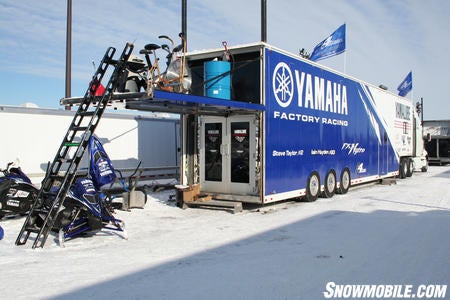
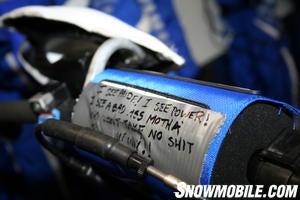
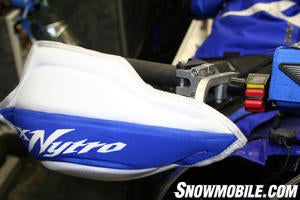
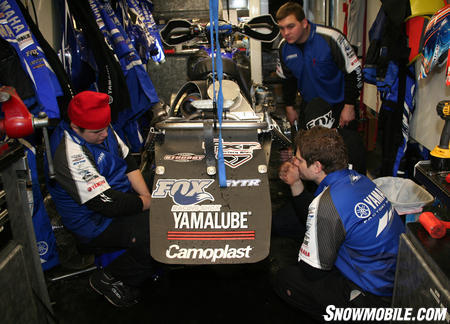
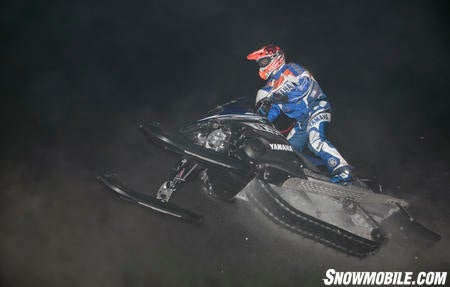





 Your Privacy Choices
Your Privacy Choices